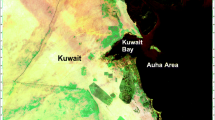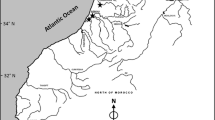Abstract
The aim of this study was to determine the extent of polycyclic aromatic hydrocarbon (PAH) pollution by measuring PAH levels and 7-ethoxyresorufin-O-deethylase (EROD) activities in flathead mullet (Mugil cephalus) samples caught from the West Black Sea coast of Turkey. The fish samples were caught in August 2008–2011. The levels of 13 PAHs were measured by high-performance liquid chromatography (HPLC) in the liver of fish. Most of the measured PAHs had three rings (low molecular weight). The frequencies of detection of PAHs were higher in fish samples caught from Zonguldak Harbour and Gülüç Stream Mouth than those from Sakarya River Mouth, Amasra and Kefken. EROD activities and cytochrome P4501A (CYP1A) protein level were also measured in the fish liver microsomes. Highly elevated EROD activities and CYP1A levels were measured in the mullet samples caught from Zonguldak Harbour and Gülüç Stream than those from Amasra and Kefken. The detection of PAHs in the liver of fish samples shows recent exposure to PAHs. The chemical analyses of PAHs and EROD activity results together reflected the extent of PAH pollution in the livers of fish caught from the West Black Sea coast of Turkey. The results indicate that Zonguldak Harbour is the most polluted site in the West Black Sea coast of Turkey.



Similar content being viewed by others
References
Addison RF (1996) The use of biological effects monitoring in studies of marine pollution. Environ Rev 4:225–237
Arinc E, Sen A (1993) Characterization of cytochrome P450 dependent mixed function oxidase system of gilthead seabream (Sparus aurata; Sparidae) liver. Comp Biochem Physiol B 104:133–138
Arinc E, Sen A (1994) Effects of in vivo benzo[a]pyrene treatment on liver microsomal mixed-function oxidase activities of gilthead seabream (Sparus aurata). Comp Biochem Physiol C Pharmacol Toxicol Endocrinol 107:405–414
Arinc E, Sen A (1999) Hepatic cytochrome P4501A and 7-ethoxyresorufin O-deethylase induction in mullet and common sole as an indicator of toxic organic pollution in İzmir Bay, Turkey. Mar Environ Res 48:147–160
Arinc E, Sen A, Bozcaarmutlu A (2000) Cytochrome P4501A and associated MFO induction in fish as a biomarker for toxic, carcinogenic pollutants in the aquatic environment. Pure Appl Chem 72:985–994
Arinc E, Kocabiyik S, Su E (2001) Induced CYP1A mRNA, protein and catalytic activity in the liver of feral fish, leaping mullet, Liza saliens. Comp Biochem Physiol C: Pharmacol Toxicol Endocrinol 128:281–290
Balch GC, Metcalfe CD, Huestis SY (1995) Identification of potential fish carcinogens in sediment from Hamilton Harbour, Ontario, Canada. Environ Toxicol Chem 14:79–91
Balkis N, Aksu A, Ersan MS (2012) Petroleum hydrocarbon contamination of the Southern Black Sea Shelf, Turkey. Environ Sci Pollut Res 19:592–599
Beg MU, Gevao B, Al-Jandal N, Beg KR, Butt SA, Ali LN, Al-Hussaini M (2009) Polycyclic aromatic hydrocarbons in three varieties of fish from Kuwait Bay. Polycycl Aromat Compd 29:75–89
Behrens A, Schirmer K, Bols NC, Segner H (2001) Polycyclic aromatic hydrocarbons as inducers of cytochrome P4501A enzyme activity in the rainbow trout liver cell line, RTL-W1, and in primary cultures of rainbow trout hepatocytes. Environ Toxicol Chem 20:632–643
Bosveld ATC, de Bie PAF, van den Brink NW, Jongepier H, Klomp AV (2002) In vitro EROD induction equivalency factors for the 10 PAHs generally monitored in risk assessment studies in the Netherlands. Chemosphere 49:75–83
Bozcaarmutlu A, Sapmaz C, Aygun Z, Arinc E (2009) Assessment of pollution in the West Black Sea Coast of Turkey using biomarker responses in fish. Mar Environ Res 67:167–176
Bucheli TD, Fent K (1995) Induction of cytochrome P450 as a biomarker for environmental contamination in aquatic ecosystem. Crit Rev Environ Sci Technol 25:201–268
Burke MD, Mayer RT (1974) Ethoxyresorufin: direct fluorometric assay of microsomal O-dealkylation which is preferentially induced by 3-methylcholanthrene. Drug Metab Dispos 2:583–588
Cohen C, Stiller A, Miller MR (1994) Characterization of cytochrome P4501A induction in medaka (Oryzias latipes) by samples generated from the extraction and processing of coal. Arch Environ Contam Toxicol 27:400–405
Curtosi A, Pelletier E, Vodopivez CL, Mac Cormack WP (2009) Distribution of PAHs in the water column, sediments and biota of Potter Cove, South Shetland Islands, Antarctica. Antarct Sci 21:329–339
Darilmaz E, Kucuksezgin F (2012) Distribution of aliphatic and aromatic hydrocarbons in red mullet (Mugil barbatus) and annular sea bream (Diplodus annularis) from the Izmir Bay (Eastern Aegean). Bull Environ Contam Toxicol 88:283–289
David A, Gomez E, Ait-Aissa S, Rosain D, Casellas C, Fenet H (2010) Impact of urban wastewater discharges on the sediments of a small Mediterranean river and associated coastal environment: assessment of estrogenic and dioxin-like activities. Arch Environ Contam Toxicol 58:562–575
Devier MH, Le Du-Lacoste M, Akcha F, Morin B, Peluhet L, Le Menach K, Burgeot T, Budzinski H (2013) Biliary PAH metabolites, EROD activity and DNA damage in dab (Limanda limanda) from Seine Estuary (France). Environ Sci Pollut Res 20:708–722
Djomo JE, Dauta A, Ferrier V, Narbonne JF, Monkiedje A, Njine T, Garrigues P (2004) Toxic effects of some major polyaromatic hydrocarbons found in crude oil and aquatic sediments on Scenedesmus subspicatus. Water Res 38:1817–1821
Ey PL, Ashman LK (1986) The use of alkaline phosphatase-conjugated anti-immunoglobulin with immunoblots for determining the specificity of monoclonal antibodies to protein mixture. Methods Enzymol 121:497–509
Fent K, Batscher R (2000) Cytochrome P4501A induction potencies of polycyclic aromatic hydrocarbons in a fish hepatoma cell line: demonstration of additive interactions. Environ Toxicol Chem 19:2047–2058
Fernandes D, Potrykus J, Morsiani C, Raldua D, Lavado R, Porte C (2002) The combined use of chemical and biochemical Markers to assess water quality in two low-stream rivers (NE Spain). Environ Res 90:169–178
Ferreira M, Antunes P, Gil O, Vale C, Reis-Henriques MA (2004) Organochlorine contaminants in flounder (Platichthys flesus) and mullet (Mugil cephalus) from Douro estuary, and their use as sentinel species for environment monitoring. Aquat Toxicol 69:347–349
Garrigues P, Djomo JE, Ferrier V, Dauta A, Monkiedje A, Ze AM, Narbonne JF (2004) Toxicokinetics of polycyclic aromatic hydrocarbons from contaminated sediment by the amphibian larvae (Pleurodeles waltl). Polycycl Aromat Compd 24:207–219
Goksøyr A, Förlin L (1992) The cytochrome P450 in fish, aquatic toxicology and environmental monitoring. Aquat Toxicol 22:287–312
Hinger G, Brinkmann M, Bluhm K, Sagner A, Takner H, Eisentrager A, Braunbeck T, Engwall M, Tiehm A, Hollert H (2011) Some heterocyclic aromatic compounds are Ah receptor agonist in DR-CALUX assay and the EROD assay with RTL-W1 cells. Environ Sci Pollut Res 18:1297–1304
Jung JH, Kim M, Yim UH, Ha SY, An JG, Won JH, Han GM, Kim NS, Addison RF, Shim WJ (2011) Biomarker responses in pelajic fish over 1 year following the Hebei Sprit oil spill (Taean, Korea). Mar Pollut Bull 62:1859–1866
Kannan K, Perrotta E (2008) Polycyclic aromatic hydrocarbons (PAHs) in livers of California sea otters. Chemosphere 71:649–655
Kammann U, Lang T, Vobach M, Wosniok W (2005) Etoxyresorufin-O-deethylase (EROD) activity in dab (Limanda limanda) as biomarker for marine monitoring. Environ Sci Pollut Res 12:140–145
Kayal S, Connell DW (1995) Polycyclic aromatic hydrocarbons in biota from the Brisbane River Estuary, Australia. Estuar Coast Shelf Sci 40:475–493
Kreitsberg R, Zemit I, Freiberg R, Tambets M, Tuyikene A (2010) Responses of metabolic pathways to polycyclic aromatic compounds in flounder following oil spill in the Baltic Sea near the Estonian coast. Aquat Toxicol 99:473–478
Laemmli UK (1970) Cleavage of structural proteins during the assembly of the head of bacteriophage T4. Nature 227:680–684
Lowry OH, Rosebrough NJ, Farr AL, Randall RJ (1951) Protein measurement with the Folin phenol reagent. J Biol Chem 193:265–275
Lu GH, Wang C, Zhu Z (2009) The dose-response relationships for EROD and GST induced by polyaromatic hydrocarbons in Carassius auratus. Bull Environ Contam Toxicol 82:194–199
McElroy AE, Farrington JW, Teal JM (1989) Bioavailability of polycyclic aromatic hydrocarbons in the aquatic environment. In: Varnasi U (ed) Metabolism of polycyclic aromatic hydrocarbons in the aquatic environment. CRC press, Boca Raton, pp 1–40
Miller KA, Addison RF, Bandiera SM (2003) Hepatic CYP1A levels and EROD activity in English sole: biomonitoring of marine contaminants in Vancouver Harbour. Mar Environ Res 57:37–54
Narbonne JF, Djomo JE, Ribera D, Ferrier V, Garrigues P (1999) Accumulation kinetics of polycyclic aromatic hydrocarbons adsorbed to sediment by the mollusk Corbicula fluminea. Ecotoxicol Environ Saf 42:1–8
Nylund L, Heikkila P, Hameila M, Pyy L, Linnainmaa K, Sorsa M (1992) Genotoxic effects and chemical composition of four creosotes. Mutat Res 265:223–236
Pathiratne A, Hemachandra CK (2010) Modulation of ethoxyresorufin O-deethylase and glutathione S-transferase activities in Nile tilapia (Oreochromis niloticus) by polycyclic aromatic hydrocarbons containing two to four rings: implications in biomonitoring aquatic pollution. Ecotoxicology 19:1012–1018
Payne JF, Fancey LL, Rahimtula AD, Porter EL (1987) Review and perspective on the use of mixed function oxygenase enzymes in biological monitoring. Comp Biochem Physiol C 86:233–245
Pekey B, Karakas D, Ayberk S (2007) Atmospheric deposition of polycyclic aromatic hydrocarbons to Izmit Bay, Turkey. Chemosphere 67:537–547
Ramalhosa MJ, Paiga P, Morais S, Ramos S, Delerue-Matos C, Oliveira MBPP (2012) Polycyclic aromatic hydrocarbon levels in three pelagic fish species from Atlantic Ocean: inter-specific and inter-season comparisons and assessment of potential public health risks. Food Chem Toxicol 50:162–167
Readman JW, Fillmann G, Tolosa I, Bartocci J, Villeneuve JP, Catinni C, Mee LD (2002) Petroleum and PAH contamination of the Black Sea. Mar Pollut Bull 44:48–62
Said TO, El Agroudy NA (2006) Assessment of PAHs in water and fish tissues from Great Bitter and El Temsah lakes, Suez Canal, as chemical markers of pollution sources. Chem Ecol 22:159–173
Salazar-Coria L, Amezcua-Allieri MA, Tenorio-Torres M, Gonzales-Macias C (2007) Polyaromatic hydrocarbons (PAHs) and metal evaluation after a diesel spill in Oaxaca, Mexico. Bull Environ Contam Toxicol 79:462–467
Stegeman JJ (1995) Diversity and regulation of cytochrome P450 in aquatic species. In: Arinc E, Schenkman JB, Hodgson E (eds) Molecular aspects of oxidative drug metabolizing enzymes: their significance in environmental toxicology, chemical carcinogenesis and health. Springer, Heidelberg, pp 135–158
Telli Karakoc F, Gaines AF, Hewer A, Philips D (2001) Differences between blood and liver aromatic DNA adduct formation. Environ Int 26:143–148
Towbin H, Staehelin T, Gordon J (1979) Electrophoretic transfer of proteins from polyacrylamide gels to nitrocellulose sheets: procedure and some applications. Proc Natl Acad Sci U S A 76:4350–4354
Unlu S, Alpar B (2006) Distribution and sources of hydrocarbons in surface sediments of Gemlik Bay (Marmara Sea, Turkey). Chemosphere 64:764–777
UNEP (1992) Determination of petroleum hydrocarbons in sediments. Reference methods for marine pollution studies. United Nations Environment Programme, Geneva, 20:36–40
van der Oost R, Beyer J, Vermeulen NPE (2003) Fish bioaccumulation and biomarkers in environmental risk assessment: a review. Environ Toxicol Pharmacol 13:57–149
Yunker MB, Macdonald RW, Vingarzan R, Mitchell RH, Goyette D, Sylvestre S (2002) PAHs in the Fraser River basin: a critical appraisal of PAH ratios as indicators of PAH source and composition. Org Geochem 33:489–515
Wakeham SG (1996) Aliphatic and polycyclic aromatic hydrocarbons in Black Sea sediments. Mar Chem 53:187–205
Acknowledgments
The authors thank all the members of the Republic of Turkey Ministry of Food, Agriculture and Livestock (Türkiye Cumhuriyeti Gıda, Tarım ve Hayvancılık Bakanlığı) for their help in collecting the fish. They also would like to thank Ilker Kopru for his help in HPLC analysis and Prof. Dr. Aysel Kukner for her technical support in laboratory studies. This research was supported by The Scientific and Technological Research Council of Turkey (TUBITAK) (Project No: 104Y083).
Author information
Authors and Affiliations
Corresponding author
Additional information
Responsible editor: Philippe Garrigues
A part of this study was presented in poster format at the 9th International Society for the Study of Xenobiotics (ISSX) Meeting (September 4–8, 2010).
Electronic supplementary material
Below is the link to the electronic supplementary material.
ESM 1
(DOC 39 kb)
Rights and permissions
About this article
Cite this article
Bozcaarmutlu, A., Sapmaz, C., Kaleli, G. et al. Combined use of PAH levels and EROD activities in the determination of PAH pollution in flathead mullet (Mugil cephalus) caught from the West Black Sea coast of Turkey. Environ Sci Pollut Res 22, 2515–2525 (2015). https://doi.org/10.1007/s11356-014-3700-3
Received:
Accepted:
Published:
Issue Date:
DOI: https://doi.org/10.1007/s11356-014-3700-3




